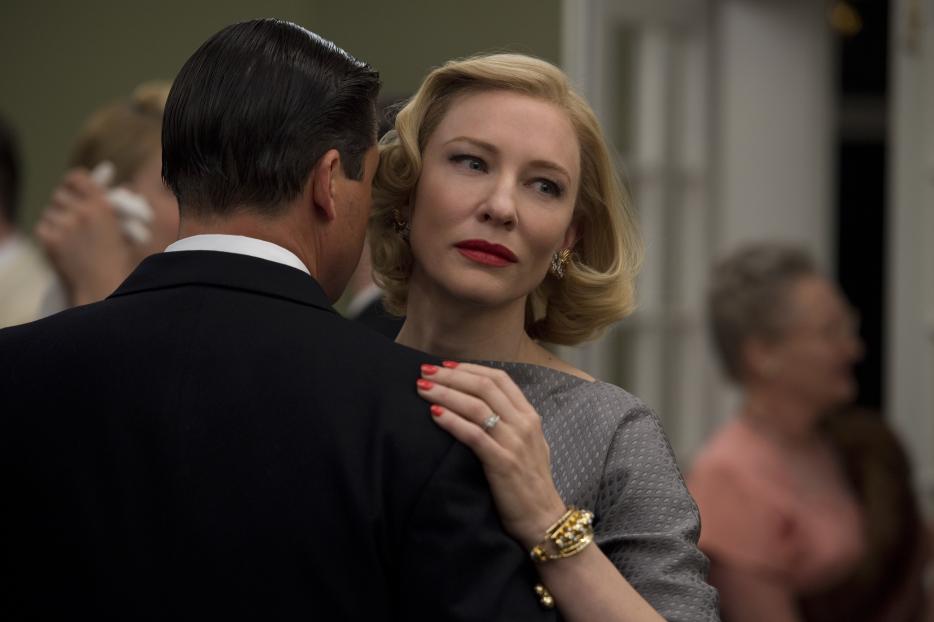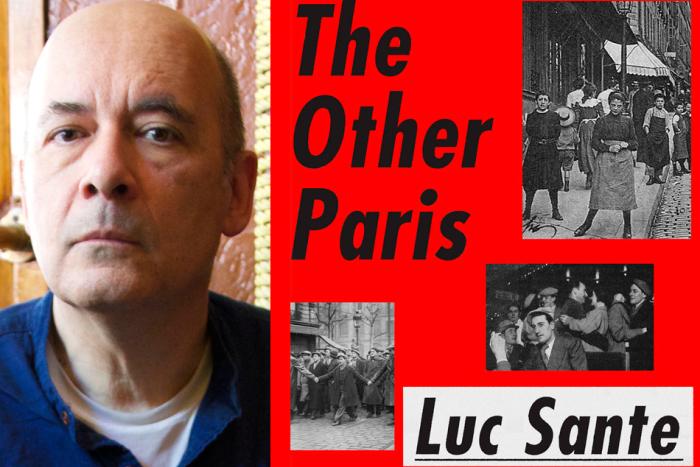“I’ll have the same,” says the girl at the diner. She’s copying the order of the older woman across the table, partially because she really wants this person to like her but also because, on some level, she wants to be more like her: more experienced, more worldly, more refined, more beautiful. In the span of four words, the fresh heat of romantic infatuation is chilled by the cold calculation of class aspiration. It’s not a case of things left unsaid, but rather of the Janus-faced aspect of language. It’s always possible to say one thing but mean two.
This beautifully written vignette is from Phyllis Nagy’s script for Carol, which last week swept the New York Film Critics’ Circle awards (winning for Best Picture, Best Director, Best Screenplay and Best Cinematography) en route to being touted in many corners as an Oscar contender. But its genesis is in Patricia Highsmith’s novel The Price of Salt, originally published in 1952 with its author writing under the pseudonym Claire Morgan after her usual publisher rejected the manuscript.
In 1990, The Price of Salt was reissued under Highsmith’s name with the title of Carol, which allowed critics to measure the distance between its frosty, New York tale of a married society woman precariously infatuated with a college-age shop-girl and the author’s famously creepy bestsellers, including Strangers on a Train (1950) and The Talented Mr. Ripley (1955). Upon closer inspection, the book felt very much of a piece with these more familiar works. With its clandestine sexual entanglements and lovers-on-the-run through-line, Carol was exquisitely fine-grained pulp—a thriller without a body count.
Even before it had the benefits of brand-name authorship, the novel was a minor classic of sorts, owing to the fact that it was one of the few works of the period to deal with a lesbian relationship without resorting to either snap judgments or lapping prurience. For Highsmith, a famously tetchy and unconventional personality whose various affairs with men and women have been dutifully reported by biographers and wags alike, a romance between two women who find each other in the charged space that opens up between social norms may have been personally revealing. The party line on The Price of Salt/Carol has thus always been that it was an act of empathetic autobiographical projection from a writer whose fortune was made as a misanthrope, and whose greatest gift had always been slipping into the skins of vain, murderous, status-climbing young men.
*
The casting of Cate Blanchett as the eponymous Carol in the film version feels inevitable: it’s a part that calls for the kind of delicate hauteur she projects in her great roles (e.g. her titular turn in Blue Jasmine), and the various ways her Carol towers over Rooney Mara’s Therese—physically and verbally, as well as in the disparities between the two actress’ track records—is wonderfully effective. And it’s easy to see why a director like Todd Haynes would be attracted to this material. Ever since his brilliant, legally un-screenable 1987 debut Superstar—a short film that dramatized the life of Karen Carpenter through the avatar of a Barbie doll being gradually whittled away to its plastic core—he’s been the great American filmmaker of furiously stifled femininity; it’s there in Safe (1995), with Julianne Moore’s existentially baffled, hyper-allergenic housewife; in Far From Heaven (2002), with its parable of forbidden interracial desire; and the superb HBO miniseries Mildred Pierce (2012), a scrupulously faithful version of the hothouse-melodrama-cum-social-realist masterpiece written in 1941 by James M. Cain.
Cain was a contemporary of Highsmith, and likely an influence as well: it’s easy to detect traces of the scheming scenarios in The Postman Always Rings Twice (1934) and Double Indemnity (1943) in Strangers on a Train, except that its co-conspirators are both men. Considering their mutual gifts for tricky plotting and shocking violence, it’s no surprise that both writers saw their work frequently mined for the big screen, and if it’s one of those curious cases of cinema history that a single director—Todd Haynes—should ultimately be responsible for making definitive films on behalf of both, it’s hardly because the other candidates are uninteresting.
“I’ll have the same—but it won’t belong to me.”
Highsmith in particular has been the muse for a murderer’s row of auteurs, starting of course with Alfred Hitchcock, whose amazingly engineered adaptation of Strangers on a Train (1951) did justice to its barely repressed homosexual subtext—manor-born sociopath Bruno (Robert Walker) all but seduces tennis pro Guy (Farley Granger) into a lethal pact— while also highlighting and exploiting the author’s troubling misogynist streak. When Bruno strangles bespectacled, belligerent Miriam (Laura Elliot) near a secluded amusement park ride, the tone is hideously exultant, and it’s hard to tell whether this attitude belongs to the filmmaker, the character, or is in the DNA of the story itself.
What Highsmith and Hitchock had in common—and were both peerless at—was forcing their respective audiences into uneasy complicity with characters doing terrible things. Officially, Psycho (1960) is an adaptation of a grim, vaguely true-crime-based novel by Robert Bloch, but the wordless, centerpiece sequence where Norman Bates (Anthony Perkins) discovers and disposes of the body of Marion Crane (Janet Leigh) is the closest the movies have gotten to the clammy excitement of the Ripley books, where the suspense always hinges on exactly how a morally reprehensible character is going to extricate himself from an impossible predicament. Highsmith’s Tom Ripley is cool and affectless where Norman Bates is nervous and melancholy, but both ultimately want to be somebody other than themselves; the difference is that Ripley, whose “talents” include forgery, imitation and the hatching of truly reptilian lies, is uniquely equipped to play dress-up games.
In the 1960s and 70s, Ripley was taken up as a film subject by European directors in various states of thrall to Hitchcock: Rene Clement’s Purple Noon (1960), starring Alain Delon in the central role, was colourful in the manner of the Master’s travelogues (To Catch a Thief, North By Northwest) but altered Highsmith’s devastatingly cruel story in The Talented Mr. Ripley in the direction of light sinister entertainment. Wim Wenders’ virtuosic The American Friend (1977) twisted Ripley’s Game (1974) into a meditation on US-European cultural exchange—now comfortably ensconced as a wealthy art forger, Ripley (Dennis Hopper) talks a German picture framer (Bruno Ganz) into doing his dirty work for him (shades of Strangers on a Train). Later, there was Hitchock loyalist Claude Chabrol’s The Cry of the Owl (1987), financed in France and Italy (and re-done in Ontario in 2009 with Julia Stiles), and last year’s under-seen and underrated The Two Faces of January, with Viggo Mortensen and Oscar Isaac giving twin master-classes in how to sweat fashionably through linen suits in the Grecian heat.
But it was actually the late middlebrow maven Anthony Minghella (The English Patient) who wrought the most intriguing variation on Highsmith’s sensibility in his deluxe 1999 mounting of The Talented Mr. Ripley, a film that fifteen years later looks like ground zero for a generation of prestige movie stars (Matt Damon, Gwyneth Paltrow, Jude Law and, yes, Cate Blanchett), not to mention the kind of classy, entirely analogue “movie for grown ups” that now rarely gets made within the studio system. In Minghella’s script, Tom Ripley is not a predatory charmer but a cornered animal, and his obsessive fixation on gilded pretty boy Dickie Greenleaf has as much to do with the latter’s executive-class wealth as his bronzed-beach-god body.
This Ripley is a desperate usurper, and yet the genius of the film is how clearly it frames him—in both visual and dramatic terms—as an outsider, capable of insinuating himself into new groups of people and yet inherently unable to settle his literal or sexual identity. Gazing at Dickie as he lounges in seaside Mediterranean splendour, Tom’s face betrays envy shaded by resignation, as if he’s thinking, “I’ll have the same—but it won’t belong to me.”
Damon makes for a strangely magnetic antihero—it helps that he’s surrounded by first-class and wonderfully expendable foils, like Philip Seymour Hoffman in peak porcine mode—but the secret heart of The Talented Mr. Ripley is Blanchett’s delicate heiress Meredith Logue, a character not in Highsmith’s novel. A privileged naïf, she falls in love with Tom at first sight, the same way Tom does Dickie, but it’s a complicated attraction; she thinks Tom is Dickie, and he keeps up the subterfuge, at first as a game and later, once he’s murdered Dickie, as a survival tactic.
The irony is that Meredith and Tom are in love with the same man and what he represents, but from different angles: for Meredith, it’s about the convenience of mating within her class, which she resents but doesn’t reject; for Tom, it’s a doubled-down desire, yearning for a status and sexual freedom that aren’t easily available to him. Meredith’s guilelessness is a narrative device, to be sure, but it’s also touching, because she seems to understand Tom even as she thinks he’s Dickie, and yet she is the last person that he can possibly confide in, since even the smallest scintilla of truth in their interactions will expose his crimes once and for all.
*
It’s fascinating to observe the gap between Blanchett then and now—from ingénue to imperious two-time Oscar winner and grand dame before her time—and to consider how these two brilliant performances in Highsmith adaptations, one in support and one at the centre, function as bookends to her career to date. But it’s also telling that in interviews, Nagy, who knew Highsmith in the years before her death and who has worked on the script for nearly two decades, says that she identifies more closely with Rooney Mara’s Therese, whose point of view is frequently privileged in Haynes’ filmmaking.
In a way, Therese, who wants to be a photographer (changed from a set designer in the novel), is a benign but still sharply reflective mirror of Tom Ripley, the amateur piano player and bathroom attendant who shadow-plays at aristocracy; like Ripley with Dickie Greenleaf, Therese wants Carol in several senses of the word. Early on in the film, in a scene that owes as much to the color-coded symbology of Nicolas Roeg’s Don’t Look Now (1974) as Hitchcock’s Vertigo (1958), Therese spies Carol walking through New York in her dark red coat—a figure of passionate attraction. But the film’s complexities turn in on themselves like an ourobourous: later, it’s Carol who stalks Therese, now similarly costumed—an acknowledgment that as much as the younger woman hungers for that beyond her station, the married mother is equally voracious, if not more so, for the opportunities and optimism afforded by a youth in which certain decisions about marriage and motherhood—and the traps they represent —have not yet been made.
These tensions are at the heart of The Price of Salt/Carol, and without the clinical, 20/20 hindsight exercised by Haynes, whose fondness for looking at the past through a glass darkly is at once his great strength—he’s a great, sensual fetishist for period textures—and arguably his most salient limitation. His cinema is almost always marked by distance, and while Carol is less formally audacious and experimental than the likes of Far From Heaven or I’m Not There (2007)—his other collaboration with Blanchett, who gender-bended to play one of several Bob Dylans—it’s still very much designed as a commentary on the past, even if some viewers might feel as if the retrograde attitudes it showcases, such as women’s limited abilities to choose their lovers or lifestyles, are hardly out of date.
The great achievement of Highsmith’s novel, even if she was unwilling to put her name to it at the time, was that it expressed dissatisfaction within and about its own present tense, and without the explicitly sinister undertones that always manifested when the author turned her attention to closeted male protagonists. History is always going to remember Patricia Highsmith as a giant in a genre whose titans were more typically male—an American analogue to Agatha Christie without all the genteel drawing-room gimmickry. Her plots’ pots boileth over, and deliciously so. But with the release of Carol, hopefully its original author will win further consideration as a socially astute and prescient dramatist. Claire Morgan and Patricia Highsmith: two great writers for the price of one.






